2015 Yamaha FJ-09: MD First Ride, Part 2 (Bike Reports) (News) by Dirck Edge

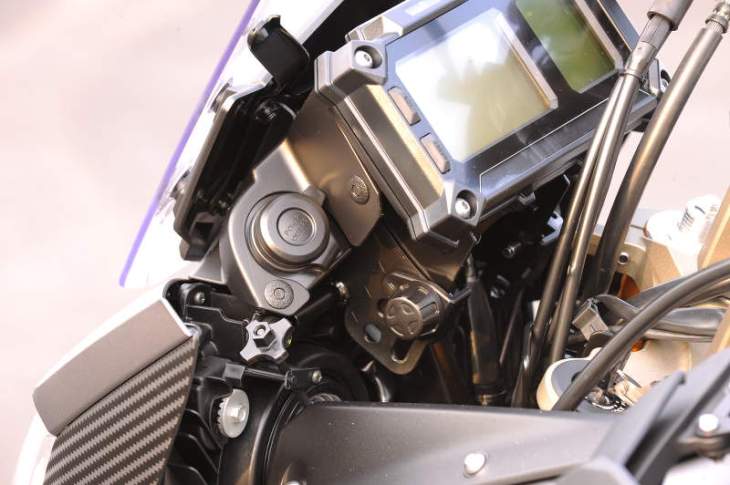
The FJ-09 offers simple adjustment of both windscreen height and headlight angle via accessible knobs under the instrument panel.
This is the completion of our report on our first ride of the new 2015 Yamaha FJ-09 sport tourer. As we stated in Part 1, the FJ-09 is based on the FZ-09. The FJ has the same engine and frame as the FZ. You can refer back to our review of the FZ-09 for the technical details. The essence of both bikes is an aluminum frame encasing an 847 cc three-cylinder, fuel injected engine with DOHC four-valve heads, staggered length intake funnels, ride-by-wire throttle and selectable fuel injection mapping (Standard Mode, Mode A and Mode B). In summary, we loved the engine in the FZ-09, but we weren’t entirely happy with the fuel injection mapping (abrupt throttle response in Mode A and Standard Mode), and the suspension was much too soft, both with regard to compression and rebound damping.
If you asked a random group of motorcycle journalists with the requisite experience three years ago to identify their favorite motorcycle, the majority would likely identify the Triumph Street Triple. A naked with a 675 cc three-cylinder engine, the Street Triple pushed the right buttons in terms of engine character and performance, as well as handling (due largely to a low curb weight). The Street Triple had that certain je ne sais quoi.
Triumph Triples may have had that certain something that couldn’t easily be described, but the Japanese ignored it. That is, until Yamaha brought back a triple in the form of the FZ-09. Listening to Yamaha describe the “cross plane concept crankshaft” and the “special feeling of connection between the throttle and the rear wheel”, we made notes, but weren’t sure what they were talking about. When we rode the FZ-09, it started to make sense.
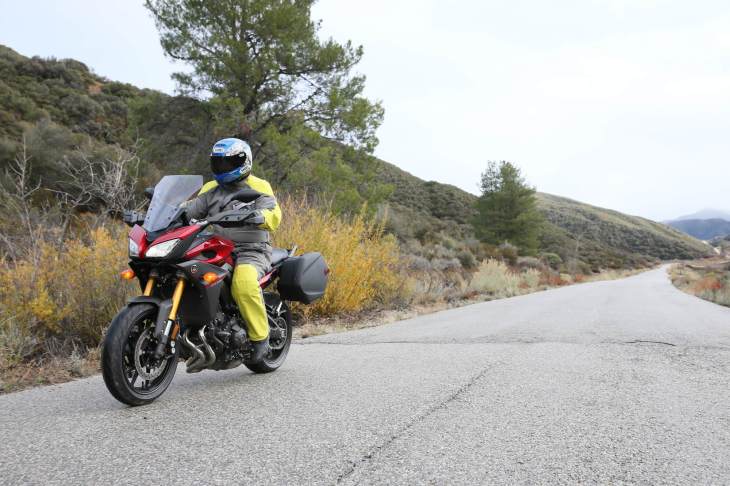
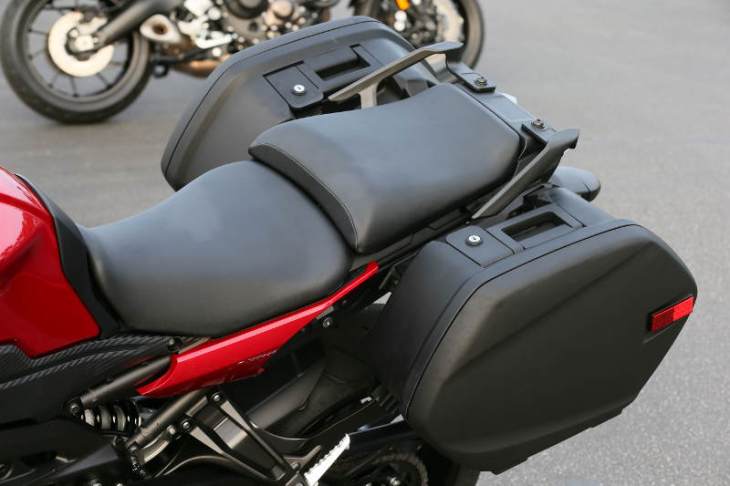
Hard on the gas, the Yamaha triple sends a wave of emotion through the rider unlike anything experienced with a twin or an inline four. It is one of those things we cannot describe adequately with words. You need to ride it and experience it for yourself. Suffice to say it is pleasurable and functional.
We dare say that the engine alone catapulted the FZ-09 to “Bike of the Year” in many motorcycle publications. This is despite the fact that the engine itself suffered from relatively poor fuel injection mapping, and the suspension was soft and sloppy. The engine is that good. Did you hear that … the engine is that good!
So we went to the launch determined to see if Yamaha had addressed the suspension and fuel injection issues. Had they done so, we expected the FJ-09 to be stellar.
The suspension is fixed, as far as we can tell after one day’s ride. Yamaha did not take half measures. Without changing the spring rates, Yamaha said during its technical presentation that new valving in the fork made compression damping 50% stiffer and rebound damping 150% slower. The shock has 150% more compression damping, as well as slower rebound. These changes are big, but the suspension needed big changes.
Yamaha addressed the throttle response issues with new ECU settings on the FJ, as well as the addition of traction control (which can be turned off).
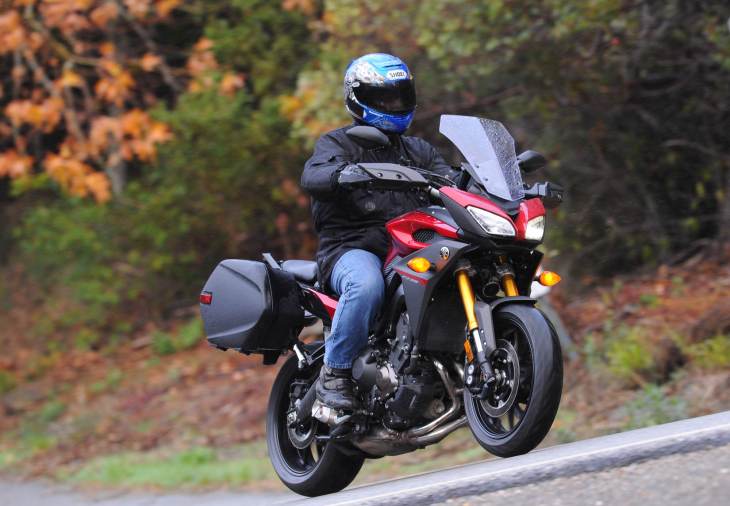
Without mentioning the new ECU settings (with revised fuel injection maps), Yamaha describes the changes found in the FJ (compared to the FZ) as follows:
Mind you, with proper fuel injection mapping and suspension, we expected the FJ to be awesome – without considering the other changes. Based on our initial ride, the FJ appears to be awesome. The suspension is dialed superbly. Despite the light weight and ultra-powerful motor, the suspension remains calm and composed, absorbing small, chatter bumps, but staying high in the stroke and minimizing excessive brake dive and acceleration squat. The suspension is very, very good.
We started out in rain on our ride (hence, my decision to switch to my full Aerostitch suit after the first photo stop), and in Standard ignition mode, I played with the off/on throttle response on the wet roads. I was impressed, and noted a significant improvement over the snatchy response I found on the FZ-09 last year. Mode B continues to be smooth, and benign, as it was last year, and Mode A is also more controllable as far as I could tell during our brief test. Keep in mind that Mode A is intended to provide extremely sharp throttle response and instant access to maximum power, which can be interpreted as an abrupt response.
So our initial test tells us Yamaha has addressed the two concerns we had about the FZ-09, but what about the rest of the package?
An entirely new rear subframe supports larger, more comfortable seating for both rider and passenger, as well as integrated luggage brackets. The rider seat is clearly more comfortable than the seat found on the FZ. It is broader and better cushioned. We will test the passenger seat when we get our long-term test unit.
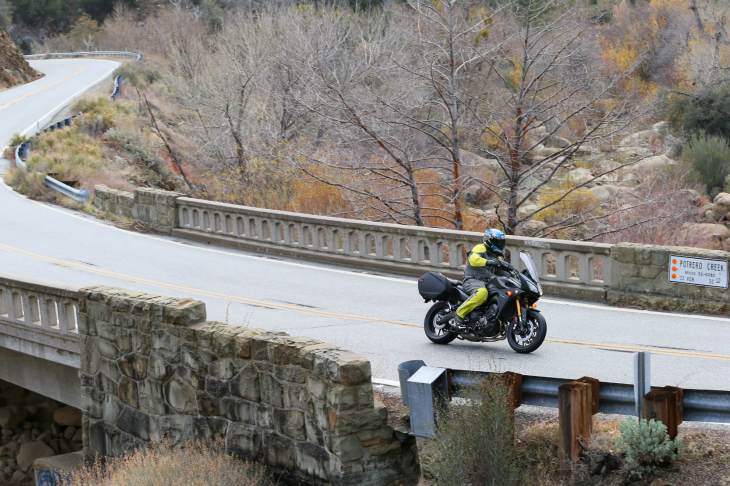
The ergonomics are excellent. The bars are higher and closer to the rider, offering a more upright position, and the distance between the seat and the pegs is larger to create a notable increase in leg room. The handlebar position is adjustable with reversible mounts (10 mm in adjustment).
The windscreen can be adjusted in height to three separate positions (a total of 30 mm range). Although requiring a bit more effort than a Kawasaki Ninja 1000 (that you can adjust quickly at a stop light, for instance), the Yamaha system is tool-less, and shouldn’t require more than a minute or so of effort. The seat can also be adjusted in terms or height (15 mm).
In addition to the added wind protection and seating comfort, Yamaha gave the FJ-09 a larger 4.8 gallon fuel tank that should provide more than 200 miles of range under normal riding conditions. Standard hand guards are welcome wind protection for your mitts.
Instrumentation is also new, with LED read-outs with good contrast and legibility. More about that in our long term test next month.
Another nod to the touring function is a standard center stand, which facilitates chain maintenance. The lack of shaft drive is a plus if you value light weight, but a negative for those looking for the ultimate in low maintenance touring.
We rode with the adjustable, standard windscreen in its highest position, and found it kept wind pressure off our chest, while leaving a clean stream of air at the helmet level. Among many accessories available from Yamaha (including the pictured saddle bags, which are optional) is a larger (both wider and taller) windscreen.
The suspension on the FZ-09 prevented us from testing handling near the limits. We are happy to report that the FJ-09, with proper suspension settings, handles much more like a sport bike than a sport tourer. Reasonably supple while cruising in a straight line, the FJ-09 can boogie in the twisties in a manner that would embarrass most other sport tourers. The engine/chassis combination can leave dedicated sport bikes for dead when an expert is at the controls. Straight line stability is good despite the remarkable nimbleness.
The six-speed transmission was unremarkable (always a good thing) in that it did its job without complaint during our test. The brakes are strong and controllable, just as we found them to be on the FZ-09 last year. In fact, the brakes acquit themselves much better on the FJ due to the stiffer fork settings.

We were very impressed by the performance of the Dunlop Sport Max D222 Roadsmart II tires fitted to the FJ-09. With a mix of wet and dry roads, and some fairly aggressive riding, these tires felt like they gripped as well as dedicated sport tires, although they are claimed to offer substantially longer life.
The FJ-09 is in another league compared to sport tourers when it comes to claimed curb weight. With a full tank of gas, Yamaha claims the FJ-09 checks in at 462 pounds. That is a remarkable figure, particularly in light of the fact that the FJ-09 offers open-class levels of power and torque.
The FJ-09 impressed us with its combination of long distance comfort and sporting capability. Most sport tourers weigh at least 100 pounds more. The FJ-09 handles like a sport bike. In the twisties, most sport tourers can change directions reasonably well and offer good mid-corner grip. By contrast, the FJ-09 feels almost like a supermoto. It is a Triumph Street Triple on steroids. It is what the FZ-09 should have been last year, together with added comfort and convenience.
We intend to test the FJ-09 further, particularly with regard to its long-distance capabilities, as well as its passenger and luggage accommodations. Obviously, we are impressed with this motorcycle, and fans of the FZ-09 might find the FJ an alternative with the fueling and suspension modifications they may have felt they needed to add to the naked version.
The 2015 Yamaha FJ-09 is available at an U.S. MSRP of $10,490 in either Matte Gray or Candy Red (both pictured in this article). Visit Yamaha’s web site for additional details and specifications.

2015 Yamaha FJ-09: MD First Ride, Part 1
You can follow any responses to this entry through the RSS 2.0 feed. You can skip to the end and leave a response. Pinging is currently not allowed.



The FJ-09 offers simple adjustment of both windscreen height and headlight angle via accessible knobs under the instrument panel.
This is the completion of our report on our first ride of the new 2015 Yamaha FJ-09 sport tourer. As we stated in Part 1, the FJ-09 is based on the FZ-09. The FJ has the same engine and frame as the FZ. You can refer back to our review of the FZ-09 for the technical details. The essence of both bikes is an aluminum frame encasing an 847 cc three-cylinder, fuel injected engine with DOHC four-valve heads, staggered length intake funnels, ride-by-wire throttle and selectable fuel injection mapping (Standard Mode, Mode A and Mode B). In summary, we loved the engine in the FZ-09, but we weren’t entirely happy with the fuel injection mapping (abrupt throttle response in Mode A and Standard Mode), and the suspension was much too soft, both with regard to compression and rebound damping.
If you asked a random group of motorcycle journalists with the requisite experience three years ago to identify their favorite motorcycle, the majority would likely identify the Triumph Street Triple. A naked with a 675 cc three-cylinder engine, the Street Triple pushed the right buttons in terms of engine character and performance, as well as handling (due largely to a low curb weight). The Street Triple had that certain je ne sais quoi.
Triumph Triples may have had that certain something that couldn’t easily be described, but the Japanese ignored it. That is, until Yamaha brought back a triple in the form of the FZ-09. Listening to Yamaha describe the “cross plane concept crankshaft” and the “special feeling of connection between the throttle and the rear wheel”, we made notes, but weren’t sure what they were talking about. When we rode the FZ-09, it started to make sense.


Hard on the gas, the Yamaha triple sends a wave of emotion through the rider unlike anything experienced with a twin or an inline four. It is one of those things we cannot describe adequately with words. You need to ride it and experience it for yourself. Suffice to say it is pleasurable and functional.
We dare say that the engine alone catapulted the FZ-09 to “Bike of the Year” in many motorcycle publications. This is despite the fact that the engine itself suffered from relatively poor fuel injection mapping, and the suspension was soft and sloppy. The engine is that good. Did you hear that … the engine is that good!
So we went to the launch determined to see if Yamaha had addressed the suspension and fuel injection issues. Had they done so, we expected the FJ-09 to be stellar.
The suspension is fixed, as far as we can tell after one day’s ride. Yamaha did not take half measures. Without changing the spring rates, Yamaha said during its technical presentation that new valving in the fork made compression damping 50% stiffer and rebound damping 150% slower. The shock has 150% more compression damping, as well as slower rebound. These changes are big, but the suspension needed big changes.
Yamaha addressed the throttle response issues with new ECU settings on the FJ, as well as the addition of traction control (which can be turned off).

Without mentioning the new ECU settings (with revised fuel injection maps), Yamaha describes the changes found in the FJ (compared to the FZ) as follows:
- Standard traction control
- Adjustable windscreen
- Adjustable handlebars
- Larger, adjustable seat
- Revised suspension
- New meter
- Standard ABS
- Long life sport touring tires
- LED headlights
- Larger 4.8 gallon fuel tank
- New fairing
- Hand guards
- Center stand
- Touring accessories
Mind you, with proper fuel injection mapping and suspension, we expected the FJ to be awesome – without considering the other changes. Based on our initial ride, the FJ appears to be awesome. The suspension is dialed superbly. Despite the light weight and ultra-powerful motor, the suspension remains calm and composed, absorbing small, chatter bumps, but staying high in the stroke and minimizing excessive brake dive and acceleration squat. The suspension is very, very good.
We started out in rain on our ride (hence, my decision to switch to my full Aerostitch suit after the first photo stop), and in Standard ignition mode, I played with the off/on throttle response on the wet roads. I was impressed, and noted a significant improvement over the snatchy response I found on the FZ-09 last year. Mode B continues to be smooth, and benign, as it was last year, and Mode A is also more controllable as far as I could tell during our brief test. Keep in mind that Mode A is intended to provide extremely sharp throttle response and instant access to maximum power, which can be interpreted as an abrupt response.
So our initial test tells us Yamaha has addressed the two concerns we had about the FZ-09, but what about the rest of the package?
An entirely new rear subframe supports larger, more comfortable seating for both rider and passenger, as well as integrated luggage brackets. The rider seat is clearly more comfortable than the seat found on the FZ. It is broader and better cushioned. We will test the passenger seat when we get our long-term test unit.

The ergonomics are excellent. The bars are higher and closer to the rider, offering a more upright position, and the distance between the seat and the pegs is larger to create a notable increase in leg room. The handlebar position is adjustable with reversible mounts (10 mm in adjustment).
The windscreen can be adjusted in height to three separate positions (a total of 30 mm range). Although requiring a bit more effort than a Kawasaki Ninja 1000 (that you can adjust quickly at a stop light, for instance), the Yamaha system is tool-less, and shouldn’t require more than a minute or so of effort. The seat can also be adjusted in terms or height (15 mm).
In addition to the added wind protection and seating comfort, Yamaha gave the FJ-09 a larger 4.8 gallon fuel tank that should provide more than 200 miles of range under normal riding conditions. Standard hand guards are welcome wind protection for your mitts.
Instrumentation is also new, with LED read-outs with good contrast and legibility. More about that in our long term test next month.
Another nod to the touring function is a standard center stand, which facilitates chain maintenance. The lack of shaft drive is a plus if you value light weight, but a negative for those looking for the ultimate in low maintenance touring.
We rode with the adjustable, standard windscreen in its highest position, and found it kept wind pressure off our chest, while leaving a clean stream of air at the helmet level. Among many accessories available from Yamaha (including the pictured saddle bags, which are optional) is a larger (both wider and taller) windscreen.
The suspension on the FZ-09 prevented us from testing handling near the limits. We are happy to report that the FJ-09, with proper suspension settings, handles much more like a sport bike than a sport tourer. Reasonably supple while cruising in a straight line, the FJ-09 can boogie in the twisties in a manner that would embarrass most other sport tourers. The engine/chassis combination can leave dedicated sport bikes for dead when an expert is at the controls. Straight line stability is good despite the remarkable nimbleness.
The six-speed transmission was unremarkable (always a good thing) in that it did its job without complaint during our test. The brakes are strong and controllable, just as we found them to be on the FZ-09 last year. In fact, the brakes acquit themselves much better on the FJ due to the stiffer fork settings.
We were very impressed by the performance of the Dunlop Sport Max D222 Roadsmart II tires fitted to the FJ-09. With a mix of wet and dry roads, and some fairly aggressive riding, these tires felt like they gripped as well as dedicated sport tires, although they are claimed to offer substantially longer life.
The FJ-09 is in another league compared to sport tourers when it comes to claimed curb weight. With a full tank of gas, Yamaha claims the FJ-09 checks in at 462 pounds. That is a remarkable figure, particularly in light of the fact that the FJ-09 offers open-class levels of power and torque.
The FJ-09 impressed us with its combination of long distance comfort and sporting capability. Most sport tourers weigh at least 100 pounds more. The FJ-09 handles like a sport bike. In the twisties, most sport tourers can change directions reasonably well and offer good mid-corner grip. By contrast, the FJ-09 feels almost like a supermoto. It is a Triumph Street Triple on steroids. It is what the FZ-09 should have been last year, together with added comfort and convenience.
We intend to test the FJ-09 further, particularly with regard to its long-distance capabilities, as well as its passenger and luggage accommodations. Obviously, we are impressed with this motorcycle, and fans of the FZ-09 might find the FJ an alternative with the fueling and suspension modifications they may have felt they needed to add to the naked version.
The 2015 Yamaha FJ-09 is available at an U.S. MSRP of $10,490 in either Matte Gray or Candy Red (both pictured in this article). Visit Yamaha’s web site for additional details and specifications.

2015 Yamaha FJ-09: MD First Ride, Part 1
You can follow any responses to this entry through the RSS 2.0 feed. You can skip to the end and leave a response. Pinging is currently not allowed.

